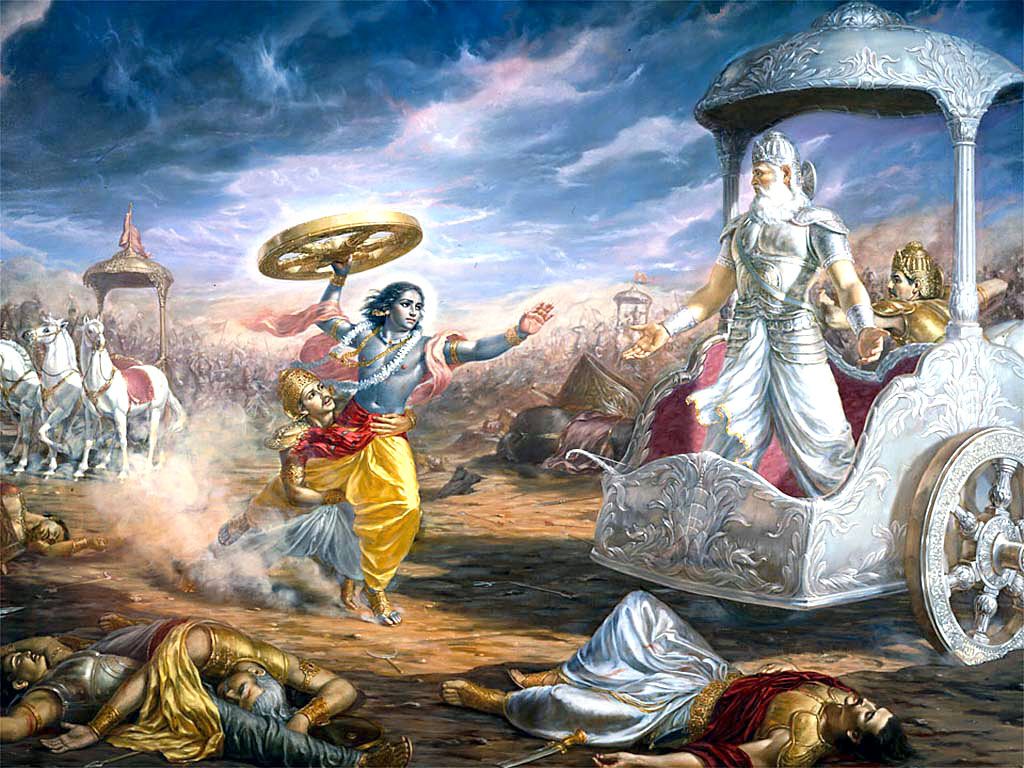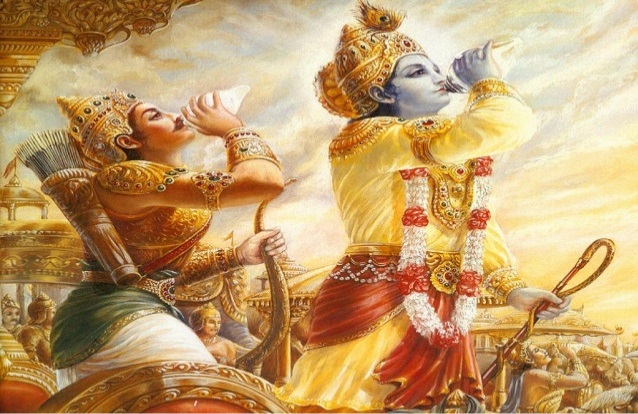The Mahabharata/Mahābhārata (US: /məhɑːˈbɑːrətə/, UK: /ˌmɑːhəˈbɑːrətə/; Sanskrit: महाभारतम्, Mahābhāratam, pronounced [mɐɦaːˈbʱaːɽɐtɐm]) is one of the two major Sanskrit epics of ancient India, the other being the Rāmāyaṇa. It narrates the struggle between two groups of cousins in the Kurukshetra War and the fates of the Kaurava and the Pāṇḍava princes and their successors.
Mahabharata is one of the most renowned Hindu epics written of all time. The story traverses over 100000 shlokas, or over 200000 verses, as each shloka is a couplet. It is written by Veda Vyasa, in Sanskrit. Consisting of about 1.8 million words, the Mahabharata is nearly 4 times more longspun than the Ramayana. The Mahabharata, meaning the great battle, chronicles the epic Kurukshetra war and the fates of Pandava and Kaurava princes. It is focused around the central theme of Dharma and contains devotional and philosophical content. The Mahabharata has been written in eighteen volumes, called parvas.

The Mahabharata is a complex and multi-layered text, consisting of 18 Parvas with over 100,000 couplets.
The article provides a brief summary of each of the 18 Parvas of the Mahabharata. Here’s a summary of the Parvas:
- Adi Parva: This is the first and the longest Parva, which introduces the main characters and sets the stage for the rest of the epic. It includes the story of the birth of the Pandavas and the Kauravas, and the events leading up to the Kurukshetra war.
- Sabha Parva: This Parva describes the events that took place in the royal court of the Kuru kingdom, including the famous game of dice that led to the Pandavas losing their kingdom.
- Vana Parva: This Parva describes the exile of the Pandavas and their adventures in the forest.
- Virata Parva: This Parva describes the Pandavas’ stay in the kingdom of Virata, where they lived incognito for a year.
- Udyoga Parva: This Parva describes the diplomatic efforts made by both sides before the Kurukshetra war.
- Bhishma Parva: This Parva describes the role of Bhishma in the Kurukshetra war and his eventual death.
- Drona Parva: This Parva describes the role of Drona in the Kurukshetra war and his eventual death.
- Karna Parva: This Parva describes the role of Karna in the Kurukshetra war and his eventual death.
- Shalya Parva: This Parva describes the role of Shalya in the Kurukshetra war and his eventual death.
- Sauptika Parva: This Parva describes the events that took place on the night after the eighteenth day of the Kurukshetra war, including the killing of the Pandava army while they were asleep.
- Stri Parva: This Parva describes the role of women in the Kurukshetra war.
- Shanti Parva: This Parva describes the aftermath of the Kurukshetra war and the efforts made by the surviving Pandavas to restore peace.
- Anushasana Parva: This Parva contains the teachings of Bhishma on dharma (righteousness) and duty.
- Ashvamedhika Parva: This Parva describes the Ashvamedha (horse sacrifice) performed by Yudhishthira to establish his dominance over the conquered lands.
- Ashramavasika Parva: This Parva describes the Pandavas’ retirement to the forest after the Ashvamedha sacrifice.
- Mausala Parva: This Parva describes the events that took place after the Pandavas’ retirement, including the destruction of the Yadava clan.
- Mahaprasthanika Parva: This Parva describes the journey of the Pandavas to the Himalayas and their eventual departure from the mortal world.
- Svargarohana Parva: This Parva describes the ascent of the Pandavas to heaven and their reunion with their loved ones.
The Mahabharata is a fascinating and complex text that offers a window into ancient Indian culture and mythology. We hope that this overview of the 18 Parvas has piqued your interest and inspired you to explore this epic further. Check out our other articles on the Mahabharata to delve deeper into its rich and varied narrative. Happy reading!
SHUBHAM!

